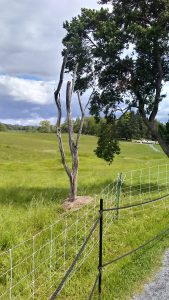
This small tree at Beaumont Hamel marks the furthest point the soldiers of the Newfoundland 1st Regiment managed to reach, and the end of my two minute walk
Today’s battlefield experiences drove home the reality of the cost in human lives that movement forward could cost in the First World War. At Beaumont Hamel we were able to re-trace some of the steps of the Newfoundland 1st Regiment as they attempted to break through German lines. In a walk that took about two minutes at a leisurely pace, I crossed the ground where 86% of the regiment fell in one morning. Of 800 soldiers who set out on the assault, only 68 remained by the end of the day. Reading those numbers on paper could only begin to help me comprehend the sacrifices that were made on that day; the numbers are difficult to visualize. Walking along their route through the shell-pocked landscape between the two ridges from which they were bombarded with sniper fire made these soldiers’ experiences more comprehensible, while at the same time making their level of determination.
We had a similar experience when Mark Symons presented his research on the Canadian struggle to take Regina Trench. Their attack over a ridge that seemed small on topographic maps became much more daunting when seen in person, reshaping our understanding of the three attempts it took the Canadians to reach their objective.
I also had an opportunity to speak about my passion for medical history. The field ambulances attached to the 2nd Canadian Division as they took the village of Courcelette on the Somme demonstrated amazing perseverance in their largely successful task of evacuating wounded soldiers through three days of intense fighting and mud. The 4th Canadian Field Ambulance took in a record 1,624 wounded men on the September 15, 1916 and managed to continue transporting them despite the loss of their horse and motor ambulances. The organisation of an efficient system took time to develop through the Great War, but provides a strong example of the benefits of the accepting input from the Medical Corps in planning military operations.
Emily Engbers, Kings University College, London Ontario
